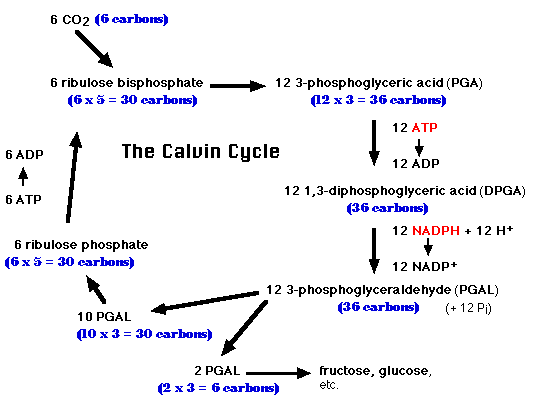Photosynthesis: Pathway of Carbon Fixation
Photosynthesis is the synthesis of organic molecules using the energy of light. For the sugar glucose (one of the most abundant products of photosynthesis) the equation is:
6CO2 + 12H2O -> C6H12O6 + 6H2O + 6O2
Light provides the energy to:
The details of these processes are described in Photosynthesis: The Role of Light.
ATP and NADPH provide the energy and electrons to reduce carbon dioxide (CO2) to organic molecules.
The Steps
- CO2 combines with the phosphorylated 5-carbon sugar ribulose bisphosphate
- This reaction is catalyzed by the enzyme ribulose bisphosphate carboxylase oxygenase (RUBISCO)(an enzyme which can fairly claim to be the most abundant protein on earth)
- The resulting 6-carbon compound breaks down into two molecules of 3-phosphoglyceric acid (PGA)
- The PGA molecules are further phosphorylated (by ATP) and are reduced (by NADPH) to form phosphoglyceraldehyde (PGAL)
- Phosphoglyceraldehyde serves as the starting material for the synthesis of glucose and fructose
- Glucose and fructose make the disaccharide sucrose, which travels in solution to other parts of the plant (e.g., fruit, roots)
- Glucose is also the monomer used in the synthesis of the polysaccharides starch and cellulose

The graphic shows the steps in the fixation of carbon dioxide during photosynthesis. These steps were worked out by Melvin Calvin and his colleagues at the University of California and, for this reason, are named The Calvin Cycle.
All the reactions of carbon fixation occur in the stroma of the chloroplast.
13 November 1996
